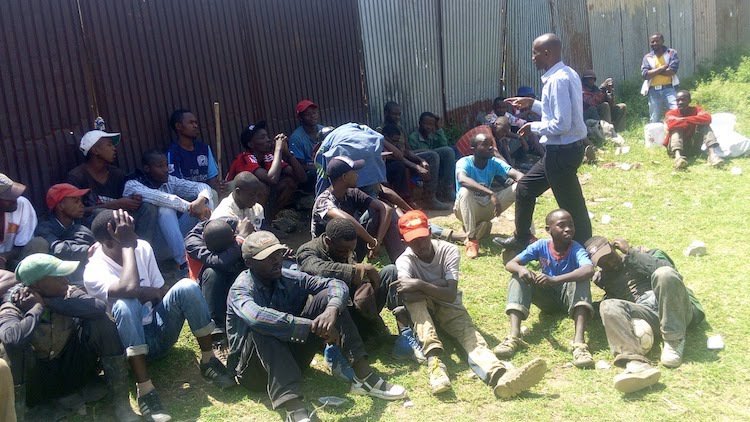By Francis Kinyua*
NAIROBI (IDN) – After being closed for nine months, schools in Kenya reopened to start a new term and resume the school year that was disrupted in 2020 as a result of the COVID-19 pandemic. On the morning of January 4, the streets were swarmed with elated children wearing colourful uniforms marching to their schools. GERMAN | HINDI | JAPANESE | THAI
Children were excited to return to school. Cate’s 12-year-old daughter Charlene, studying in New Pumwani Primary school, said staying at home had been tiresome and boring. “I missed learning, I missed my peers and teacher, and I am happy to return back to school,” she said.
After visiting a few schools, the Kamukunji Community Empowerment Initiative (KCEI), a community-based group working in Kamukunji sub-county to enable youth to face their life challenges, observed that school authorities had installed sanitising machines, provided clean water, and made facemasks mandatory for entering the premises.
Most boys and girls put on masks as they queued outside their school’s gates, waiting their turn as school officials took temperatures and sprayed hand sanitisers into their palms, but the actual danger waited inside the school.
Parent’s concerns
Parents accompanying their children were happy and anxious at the same time as they were worried about their safety as Kenya continues to report new COVID-19 infections.
“As a parent, I am pleased that the children are back in school,” said Irene, a parent. “But at the same time, we have a lot of fear because we really don’t know if other children have the virus or even if the teachers have the virus, or even if the support staff in school have the virus. So, we have that concern, but we actually hope that our kids will be safe,” she said.
“The government has said our children should go back to school, but they are not safe as I see it,” said 30-year-old parent Saida, inquiring how social distancing will be practised with about 70 students squeezed into each classroom. “There are no new classrooms built and no additional desks here,” she added. When the children sat down for class, they were shoulder to shoulder, three at a desk, as they were before the pandemic.
“Our school is overcrowded, that is my leading concern in bringing my children back,” the mother said. “We have suffered as parents, we have no money to buy books, pay bus fares, and meet the costs of masks and sanitisers. We are not sure of the safety of our kids in schools. I am worried but I have to obey the government and take my child back to school,” she said.
Absenteeism
In 2020, the World Health Organisation and UNICEF raised the alarm about prolonged school closures due to COVID-19, stating that the closure may increase the risks of teenage pregnancy, poor nutrition and permanent school dropouts for children in poorer countries.
While 15 million children were expected to return to school this week, KCEI observed that hundreds of children failed to report back to school in the Pumwani slums, with girls forming the largest part of these figures. While it has not yet been determined why pupils did not go back to school, it could be due to girls becoming pregnant or marrying, so they are unable to return to school. “School provided a safe haven for female students to focus on their studies and avoid the marriage route”, KCEI member Kinyua said. “But due to Covid-19, the safety net was detached, leaving them exposed to child marriage.”
With diminishing household income, boredom and idleness, other learners resorted to child prostitution, drugs/alcohol, hawking, collecting scrap metals and plastics for sale, and begging during closure to supplement the household income, and this could also be a contributor to increased school absentee numbers during the school opening.
As many in the country are complaining about job losses and business closure due to pandemics and restrictions, many parents told KCEI that they are hesitant to send their children to school because the loss of income has affected their ability to pay tuition and other levies, buy new school uniforms, books and face masks, among others. “We have not worked for a year. We were confined to our homes. How are we to support our children to go back to school,” said Jane, a parent at Kamukunji Secondary School.
“On top of the hand-washing points, schools need an adequate supply of water, soap and hand sanitisers for teachers and students. We also have a shortage of classrooms and desks, which makes it hard to properly observe the one-metre rule among learners,” the headteacher at Pumwani Primary school said.
Overall, KCEI observed an average of 70 per cent of students returned to school this week. While the number may seem high, there is fear among teachers and school staff that children will continue to drop out of school for various socioeconomic reasons throughout the year.
In order to achieve Goal 4 (Quality education for all) of the United Nations’ Sustainable Development Goals (SDGs), all children despite their socioeconomic status should have equal access to education, hence all stakeholders should work together to make this goal a reality. [INPS Japan/ IDN-InDepthNews – 27 January 2021]
* Francis Kinyua belongs to the Kamukunji Community Empowerment Initiative.
Photo: Kamukunji Community gathering.




